
Fall protection: essential components
Working at height involves a lot of risks. In a workplace where people can fall, you need extra protection: fall protection.
Of course, preventing fall accidents as much as possible is the very best thing. With careful risk assessment, you reduce the risk of falls and make the environment safer for your colleagues.
This can be done, for example, by using good scaffolding on solid ground. Or placing a fence around the workplace. This is suitable, for example, as fall protection on a roof.
These collective measures to increase worker safety are called permanent fall protection. This allows every worker to work safely without other measures.
But in some work situations, collective measures are not enough or not possible. What then?
Personal fall protection
In certain working conditions, collective measures do not provide sufficient protection. Or it is not possible to install them. It is not possible to install a fence everywhere (because of constructional reasons).
Then personal fall protection is the solution to help people work more safely at heights.
When is fall protection mandatory?
When working from a height of 2 meters, fall protection is mandatory. In the Netherlands this is from 2.5 meters and in France fall protection is required when there is a risk of falling without more explanation.
But when there is a greater risk of falling, this can also be the case at a lower height. This includes, for example, working on or next to traffic routes or above water.
Four essential components of fall protection
Depending on the working conditions and work environment, there are different types of fall protection. But for all types, there are 4 components that complete the fall protection system. They are..
- Anchor points
- Harnesses and positioning
- Connectors, such as fall arrest devices and safety lines, to attach a fall harness to an anchor point
- Devices for rescue at height or entry into confined spaces
Anchor Points
Anchor points can be used in a number of ways. There are..
- fixed anchor points attached to a structure or buildin
- anchor points that are part of an installed system designed for fall protection
- mobile anchor points: temporary and movable and you can attach them to a structure or building if necessary
6 types of anchor points
6 types of anchor points: A, B, C, D, E and F. The following explains the differences between the types and how to use them.
Type A are one or more fixed anchor points that require a structural anchor to attach them to a structure, such as a wall. We call these fixed anchor points.
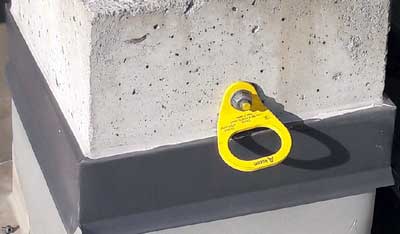
Rescue and descent
Another component of a properly functioning fall protection system is rescue systems and devices for safe descent. With these devices, you lower the victim until he is safe. You can also use them to enter a confined space.
Every second counts. Rescuing yourself or a colleague (yourself) after a fall is crucial to prevent, for example, harness suspension trauma.
The most commonly used devices for rescue and/or descent are..
- descent devices
- tripod or davit lifting systems
Descent devices allow you to descend in a controlled manner. So you can't always rescue yourself or colleagues with them. It depends on the model.
With certain models, during an assisted rescue, you can elevator the victim to the top, remove the fall harness and place the other person safely on the ground.
Type B are one or more fixed anchor points that you just don't attach to a structural anchor (tripod). These are mobile anchor points.
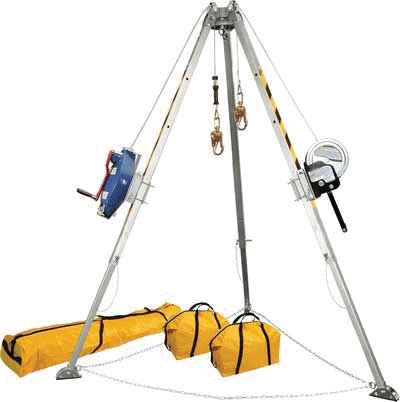
Type C are davit systems that allow different scenarios. They are mainly for descending into confined spaces and then hoisting yourself back up.
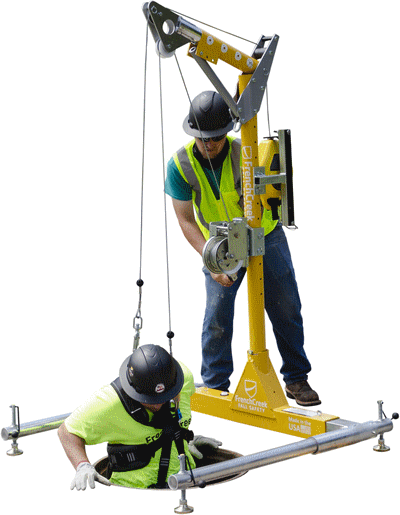
To ensure your safe descent, combine davit systems with a winch or fall block. If you choose a fall block with a winch, you won't have to enter the space yourself and avoid any risks. You then mount this block on the davit system.
The difference between a davit and a tripod
A davit system has a few key advantages over a tripod..
- It needs a smaller footprint
- Different locations are possible thanks to different feet
- A huge number of combinations are possible
Type D are flexible anchor lines attached to end anchors to which you can attach your fall harness by means of a connector or musketon. Examples are cables or ropes (webbing).
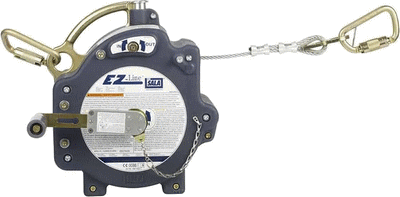
Type E are rigid anchor lines attached to end anchors. To these you attach the fall protection with a connector or musketon. Examples of this type of protection are rail systems and tubes.
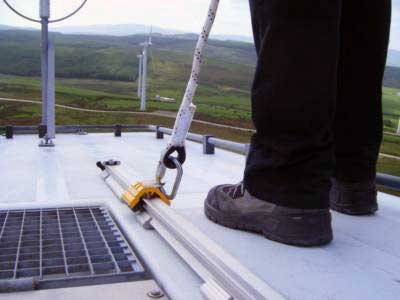
Type F are deadweight anchors. With these types, you place freestanding anchor points on a roof. You hang weights from those anchor points to ensure the anchor does not move.
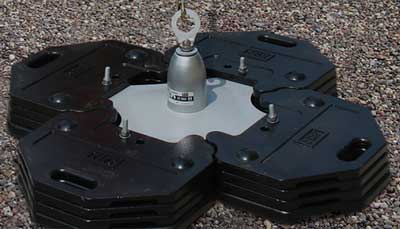
Choice of anchor point
It is enormously important to choose the right anchor point and location for every unsafe work situation. This is because the location of the anchor point determines the fall factor.
The fall factor is the ratio between the height at which a person is at and the length of the line that catches the fall. There are 3 fall factors: 0, 1 or 2. The images below clarify the differences between the fall factors.
When calculating the location of the anchor, you take into account several things: the length of the lifeline and the tear out of the damper of the lifeline, the length of the carrier of the fall arrest device and the mandatory free space.
Connectors: attach the fall harness
The fall harness must be securely and safely fastened at all times. Otherwise, accidents can still happen!
You attach a fall harness to the anchor point with special safety lines and/or fall arrest devices. These are called connectors.
The main function of the connection between an anchor point and a fall harness is to arrest a possible fall and slow it down. The forces released on the body will then be less than 6kN.
Without this cushioning, forces released on the body can exceed 18kN. This corresponds to about 2 tons.
Safety Lines
Safety lines have multiple functions when it comes to (preventing) fall accidents. They are suitable for fall protection, area limitation, positioning and rescue.
With fall protection, there must always be a damper. Your lifeline should also never be longer than 2 meters. The total length of the line also helps determine the choice of your anchor point.

Fall arrest devices
The operation of fall arrest devices or fall blocks can be compared to that of a seat belt. A seat belt automatically rolls back and locks after a short braking distance in the event of a large, sudden acceleration.
In the event of a fall, a fall arrest device ensures that this happens with the line.

Unlike with lifelines, fall arrest devices require less clearance below the suspension point. This is because the blocks of fall arrest devices block the fall almost immediately.
Working horizontally
The disadvantage of fall arrest devices is that people often use them horizontally, that is, at an angle greater than 30°. But this is incorrect and also unsafe! This is because you then get a pendulum effect. As a result, you can still bump into structures.
On flat or slightly sloped roofs, use a fall arrest block that is actually suitable for horizontal use. The pendulum effect cannot be completely avoided. However, these blocks do have a cable that is more resistant to rubbing against the edges of horizontal structures. This prevents cables from wearing out and becoming weaker, with all the consequences that entails.
Vertical lines with a clamp
For vertical applications, such as temporary climbing path protection, you can choose to secure with a safety line with a line clamp attached.
This clamp, clamps the rope in the event of a fall. In this way, it arrests the fall after a stopping distance. The advantage of this type of security is that you can easily disengage when you get to the work area. With fall blocks, this is difficult. The cable or strap rolls back into its housing as soon as you disconnect it from the fall harness.
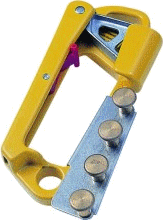
Fall harnesses
There are 3 types of fall harnesses..
Only harnesses with shoulder and leg straps are suitable for catching a fall. So under no circumstances use only a lumbar or hip belt as fall protection.
- standard fall arrest harness
- positioning harness
- seat harness
Standard fall arrest harness
A standard fall harness is used to arrest a fall. This type has one anchor point on the chest and/or back to connect a safety line or fall block to an anchor point.
Premium fall harnesses have some features that basic harnesses do not. For example, they have extra reinforcement on the shoulders, are quicker to put on or have extra suspension trauma straps.
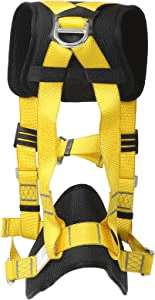
Positioning harness
A positioning harness should only be used for positioning and area restraint. You cannot use this type to catch a fall!
This harness has anchor points on the back and/or chest and 2 D-rings for a positioning harness. These D-rings are not intended for attaching a safety line or fall block or for connecting the harness to an anchor point.
Use the harness in conjunction with a positioning line to work hands-free.
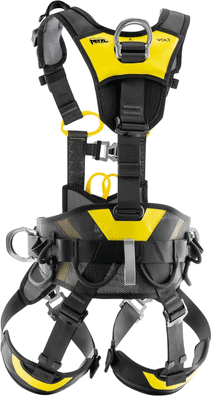
Seat harness
This type of harness has an anchor point on the chest and back, a positioning belt and a D-ring at the level of the navel. This allows you to descend safely on a winch or rope and work while seated.
A sitting harness is often recognized by the straight leg straps.
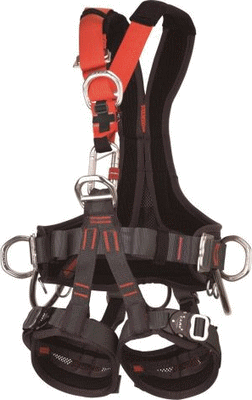
Conclusion: always pay attention!
Fall protection is never the same. There are vastly different work conditions and scenarios possible, all of which require specific fall protection.
You should not only consider the most appropriate equipment for your company's employees when purchasing. You must also always be careful to combine the right products to provide the best protection.
Personal protection equipment is very important, but using and maintaining it is just as important. Then you can use them longer and it helps prevent accidents. So everyone can go home safe and sound again!